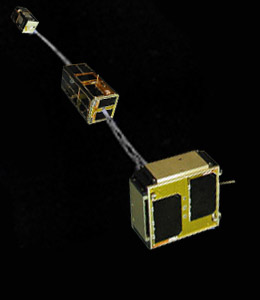Thank you very much for visiting Gunter's Space Page. I hope that this site is useful and informative for you.
If you appreciate the information provided on this site, please consider supporting my work by making a simple and secure donation via PayPal. Please help to run the website and keep everything free of charge. Thank you very much.
MAST
 MAST [TUI] |
 MAST [TUI] |
The MAST (Multi-Application Survivable Tether) Experiment is a low-cost CubeSat experiment to demonstrate space tether survivability. It consists of three tethered CubeSats.
TUI and Stanford University's Space Systems Development Laboratory have teamed to develop and fly a small, very inexpensive experiment to demonstrate TUI's Hoytether technology and obtain on-orbit measurements of the degradation of space tethers by orbital debris and micrometeorites. The lifetimes of current single-line tethers are limited by damage due to meteorite and orbital debris impactors to periods on the order of weeks. Although single-line tether lifetimes can be improved by increasing the diameter of the tether, this incurs a prohibitive mass penalty. The Hoytether is a tether structure composed of multiple lines with redundant interlinking that is able to withstand many impacts.
For launch, these three picosatellites stack together into a volume about the size of a loaf of bread. Once on orbit, the picosatellites will separate and deploy a 1,000 meter long Hoytether structure.
The middle picosatellite, called "Gadget", will then slowly crawl up and down the tether, taking pictures of the tether as it goes. These pictures will be transmitted to a ground station for analysis to determine how quickly the tether experiences damage due to impacts by micrometeoroids and orbital debris, as well as due to erosion by atomic oxygen and UV light.
In addition, all three picosatellites contain GPS receivers, and data from these receivers will be collected to provide information on the dynamics of tethered formations of spacecraft and the performance of our tether deployment technologies.
The total cost of the MAST program is expected to come in at under $ 1M, proving that good science can be accomplished in very low cost flight missions. The MAST program has been funded through a combination of private and government research funds. The development of the underlying technologies was funded by a NASA Small Business Technology Transfer (STTR) contract. The construction and qualification testing costs for the picosatellite flight models and the launch costs have been funded by TUI internal funding and private investments.
The satellite was successfully deployed in orbit, and signals were received only from the Gadget crawler, and the 1 km tether did not fully deploy.
| Nation: | USA |
|---|---|
| Type / Application: | Technology |
| Operator: | Tethers Unlimited, Inc. |
| Contractors: | Tethers Unlimited, Inc. |
| Equipment: | |
| Configuration: | 3 CubeSats |
| Propulsion: | None |
| Power: | Solar cells, batteries |
| Lifetime: | |
| Mass: | 3.21 kg |
| Orbit: | 647 km × 782 km, 98.08° |
| Satellite | COSPAR | Date | LS | Launch Vehicle | Remarks | |
|---|---|---|---|---|---|---|
| MAST | 2007-012K | 17.04.2007 | Ba LC-109/95 | Dnepr | with EgyptSat 1, Saudisat 3, SaudiComsat 3, SaudiComsat 4, SaudiComsat 5, SaudiComsat 6, SaudiComsat 7, CP 3, CP 4, CAPE 1, Libertad 1, AeroCube 2, CSTB 1 |
References:
- Tethers Unlimited, Inc.: MAST website
